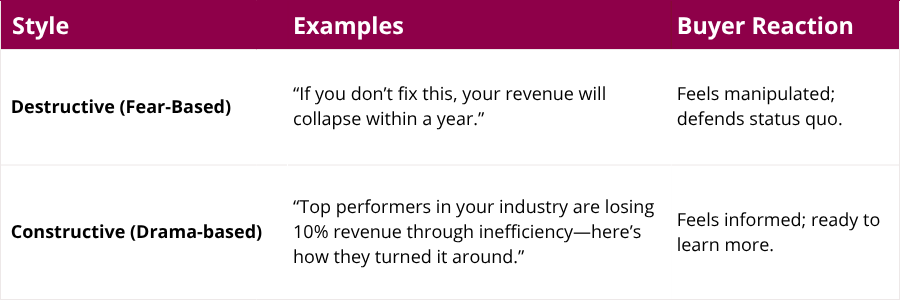How to Build Tension in Your Commercial Teaching Message
In B2B sales, the most powerful messages aren’t horror stories, they’re dramas with a clear plotline: the buyer’s current way, the mounting risk of staying there, and the new path to change. A commercial teaching message should create constructive tension that challenges how buyers think, not fear that paralyzes them.
When sales professionals learn how to build tension in sales conversations, they give customers a reason to change, not a reason to retreat.
Why Fear-Based Messaging Fails in B2B Sales
Fear may capture attention, but it rarely drives action. When sellers use “doom and gloom” messaging—telling buyers their business will collapse without change—it often backfires.
Buyers feel manipulated or defensive. Instead of leaning in, they tune out. That’s because fear-based messaging triggers loss aversion — the psychological tendency (from Prospect Theory) to overvalue what we already have and avoid risk.
In B2B sales, that means fear reinforces the status quo bias, making prospects more likely to do nothing.
Quick takeaway: Fear freezes buyers. Constructive tension frees them.
What Is Constructive Tension in a Commercial Teaching Message?
Constructive tension is the balance between urgency and credibility. It’s the emotional spark that makes buyers re-evaluate their assumptions.
In Challenger methodology, tension doesn’t come from fear. It comes from insight. The seller helps the buyer realize a gap or missed opportunity—something costly, but fixable—and then guides them to a better way.
Think of it as a drama, not a horror story:
In a drama, the audience feels suspense but believes resolution is possible.
In a horror story, the audience feels doomed and powerless.
Your goal is to guide buyers through tension that builds belief, not anxiety.
Example: “Your revenue model is strong, but your renewal process is leaking margin every quarter. Here’s how your peers fixed it.”
That’s tension with purpose, not terror.
How to Build Tension in Sales Conversations
Building commercial teaching message tension is a craft. Here’s a practical framework to apply:
- Lead with empathy and relevance – Show that you understand the customer’s world. Use data and examples drawn from their industry.
- Expose a risk, but make it solvable – Highlight the cost of inaction or the blind spot that’s quietly eroding results. Don’t exaggerate; precision builds credibility.
- Make the story emotional and relatable – Emotion drives decisions. Use analogies or short stories that make the insight memorable—not statistical overload.
- Show a credible resolution – Offer a path forward where the buyer sees control, clarity, and measurable gain.
- Anchor the solution in commercial insight – End with an insight only your team could have revealed — a perspective rooted in data and experience.
This approach transforms B2B storytelling from “problem-panic-pitch” into a narrative that challenges thinking and earns trust.
Common Messaging Mistakes to Avoid
Even strong sales teams make these missteps when trying to create tension:
- Going too dark, too fast. If your message sounds apocalyptic, buyers emotionally check out.
- Skipping the setup. Without context, even valid insights feel abrupt or irrelevant.
- Neglecting the resolution. Always show a clear path from problem to solution — tension must pay off.
- Overusing data without story. Facts inform; stories persuade. Use data to sharpen emotion, not replace it.
- Forgetting your audience. Executives want perspective, not panic.
Examples of Constructive vs. Destructive Tension

The difference is subtle but critical. In the first, the seller tells a horror story. In the second, they build a drama where the buyer plays the hero.
For Sales Leaders and Enablement Professionals
Enablement teams can help sellers master this craft by embedding it into training, coaching, and message design:
- Audit your messaging for fear-based language.
- Reinforce the structure: setup → insight → resolution.
- Coach sellers to use questions that guide discovery, such as:
- “What risks are most underestimated in your current process?”
- “Where do you see blind spots competitors have already fixed?”
- Role-play conversations to build confidence in handling tension without fear tactics.
FAQ
Q: Why does fear-based messaging fail in B2B sales?
A: Fear triggers buyer defensiveness and strengthens the status quo bias. Buyers prefer to protect what they have rather than risk change.
Q: What is constructive tension in sales messaging?
A: It’s the strategic balance between urgency and credibility that helps buyers see a problem worth solving — without feeling overwhelmed or threatened.
Q: How can I build tension in sales conversations?
A: Start with empathy, reveal a solvable risk, tell a story that evokes emotion, and close with a data-backed resolution.
Q: What’s the difference between drama and horror in sales storytelling?
A: Drama builds curiosity and momentum; horror builds fear and paralysis. Choose drama to motivate action.
Key Takeaways
- Constructive tension helps buyers change; fear shuts them down.
- Build stories that show risk with resolution.
- A great commercial teaching message is dramatic—not terrifying.
- Emotion, credibility, and insight create the momentum for change.
Learn how we teach sellers to effectively use constructive tension in sales calls to become Challengers.
Sarah Cheatle
More from our blog
3 Challenger Skills That Boost Sales Rep Productivity and Motivate Buyers
Sales leaders everywhere are looking for ways to improve sales rep productivity. But productivity isn’t just about efficiency—it’s about…
The Next Era of Challenger Selling: Skills That Will Shape the Future of Sales
In 2020, selling changed overnight. Buyers went quiet, priorities flipped, and digital interactions replaced boardroom handshakes. Everyone talked…
Stop pitching AI. Start teaching it: The Challenger Way
Key takeaways Most AI deals stall because buyers don’t know how to buy, not because of product limitations. Traditional feature-based pitches…
What are you waiting for?
Transform your sales team.
The best companies grow, and grow fast, by challenging customers, not by serving them.




